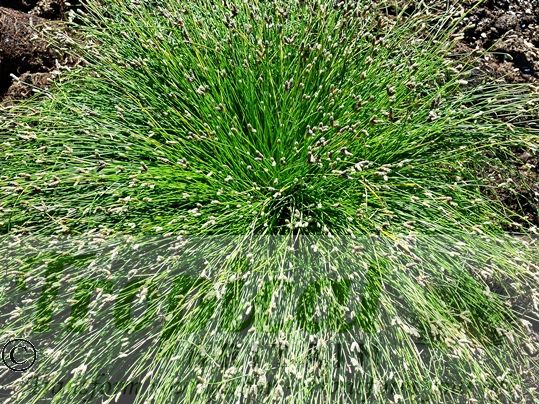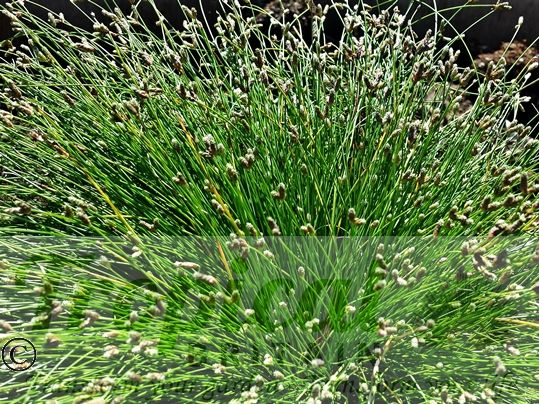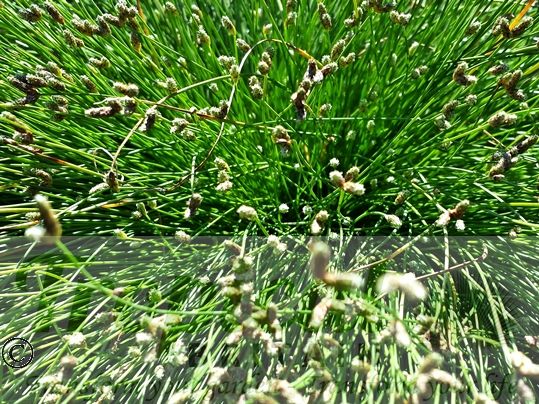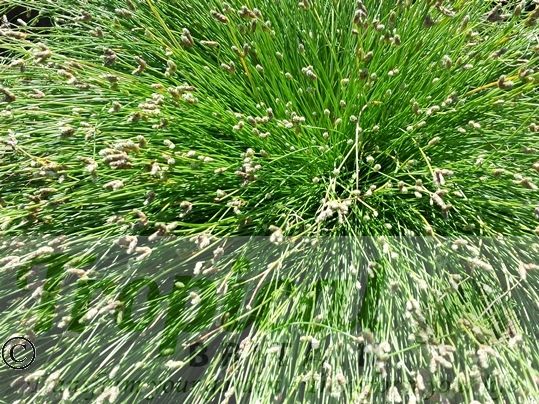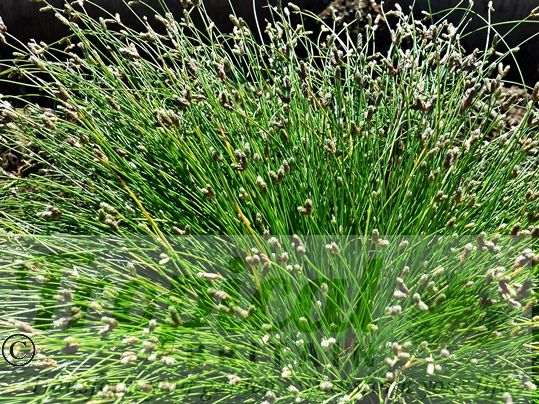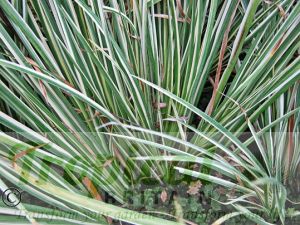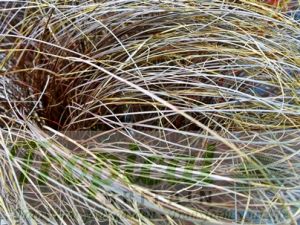Isolepis cernua, Slender Club Rush or often called Fibre Optic Grass, is a highly attractive low-growing perennial sedge that is hardy to around -10C. It is typically found in coastal habitats in sand or moist soils and has an extraordinary wide global range being native to Europe, the west coast of Northern America, Australia and New Zealand. The observant botanist will find it growing in maritime ecosystems in many UK counties although it is never especially abundant and often a rare sighting.
As a plant for the garden, Isolepis cernua is a wonderful, rather quirky plant, with long tall stems that arch over gracefully in tufty highly ornamental clumps. It has small cone shaped terminal inflorescences that are silvery-white turning brown as the season progresses. It is these inflorescences held at the end of the stem that gave it the name Fibre Optic Grass, a name that seems more and more incongruous and outdated the further we get from the 1970's.
Isolepis cernua is one of those plants that is curiously over-burdened with synonyms but in the UK it is often sold as Scirpus cernuus.
It is an ideal plant for a moist sheltered position, particularly as a marginal around a pond or bog garden. It can also be immersed fully in water providing that this is done gradually giving it time to adjust to the rising levels. But it is such a odd-ball of a plant it can be used effectively in any number of different creative planting combinations.
It definitely should be used more often in new and imaginative modern ways to help it throw off that unfortunate and undeserved 1970's association.
Recommended.
Additional Information
| Order | Poales |
|---|---|
| Family | Cyperaceae |
| Synonyms | Cyperus ambiguus, Cyperus pumilio, Cyperus pumilio, Eleogiton cernua, Fimbristylis pygmaea, Isolepis brachyphylla, Isolepis brevifolia, Isolepis brevis, Isolepis cernua f. aphylla, Isolepis cernua var. cernua, Isolepis chaetodes, Isolepis chlorostachya, Isolepis controversa, Isolepis erubescens, Isolepis furcata, Isolepis fuscata, Isolepis heterolepis, Isolepis heterophylla, Isolepis kochii, Isolepis leptalea, Isolepis leptocaulis, Isolepis magellanica, Isolepis meyeniana, Isolepis microcarpa, Isolepis minaae, Isolepis modesta, Isolepis monostachya, Isolepis multicaulis, Isolepis nervosa var. campana, Isolepis nervosa var. sicula, Isolepis numidiana, Isolepis pholiodes, Isolepis prolifera, Isolepis pumila, Isolepis pumilo, Isolepis punctulata, Isolepis purpurascens, Isolepis pygmaea, Isolepis pygmaea var. brevis, Isolepis pygmaea var. californica, Isolepis pygmaea var. elongata, Isolepis pygmaea var. pallida, Isolepis pygmaea var. sanguinea, Isolepis riparia, Isolepis rupestris, Isolepis saviana, Isolepis saviana var. tenuis, Isolepis savii, Isolepis setosa, Isolepis sicula, Isolepis striatella, Isolepis subprolifer, Isolepis tenuipes, Isolepis tenuis, Isolepis trachycarpa, Isolepis trigyna, Schoenoplectus cernuus, Schoenoplectus savii, Schoenus nitens, Scirpus acicularis, Scirpus aphyllus, Scirpus arechavaletae, Scirpus brevis, Scirpus cernuus, Scirpus cernuus f. aphyllus, Scirpus cernuus var. brevis, Scirpus cernuus subsp. californicus, Scirpus cernuus var. californicus, Scirpus cernuus var. durus, Scirpus cernuus f. macrostachyus, Scirpus cernuus f. pygmaeus, Scirpus cernuus var. pygmaeus, Scirpus cernuus var. vahlii, Scirpus chaetodes, Scirpus chloroticus, Scirpus filiformis, Scirpus gracilis, Scirpus hookeri, Scirpus leptaleus, Scirpus microstachys, Scirpus minaae, Scirpus minimus, Scirpus modestus, Scirpus nervosus var. campanus, Scirpus nervosus var. siculus, Scirpus nudipes, Scirpus numidianus, Scirpus pictus, Scirpus pumilus, Scirpus pygmaeus, Scirpus riparius, Scirpus savii, Scirpus savii subsp. campanus, Scirpus savii f. controversus, Scirpus savii var. filiformis, Scirpus savii var. fuscescens, Scirpus savii var. major, Scirpus savii subsp. minaae, Scirpus savii var. minaae, Scirpus savii var. mixtus, Scirpus savii f. todaroanus, Scirpus savii var. vahlii, Scirpus savii subsp. vahlii, Scirpus setaceus var. pygmaeus, Scirpus setaceus var. pygmaeus, Scirpus setaceus var. savii, Scirpus subprolifer, Scirpus subtilis, Scirpus terminalis |
| Geographical Origin | Wide global distribution: UK, Europe, west coast of Northern America, Australia, New Zealand |
| Cultivation | Full sun or partial shade. Mild sheltered spot. Prefers moist soil: can be an aquatic or water marginal |
| Eventual Height | 20cm |
| Eventual Spread | Spreading in clumps and self seeding |
| Hardiness | Down to about -10C. Appreciates the mild maritime air. Not fully hardy in colder regions or in a very harsh winter. Apply a thick mulch around the roots and cover with fleece. You can also pot them up in containers and bring them indoors |

Free DELIVERY
ON ALL ORDERS OVER £99THIS OFFER IS VALID ON ALL OUR STORE ITEMS.

